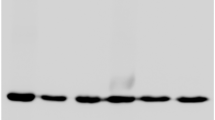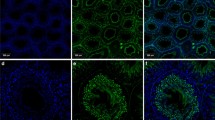Abstract
It has recently been shown in mice that the plasma membrane Ca2+-ATPase isoform 4 (PMCA4) is essential for sperm fertilization capacity. We analyzed whether sperm PMCA4 is formed in the rat during spermatogenesis or is synthesized in the epididymis and transferred onto sperm during sperm maturation. We could show that PMCA4 is conserved in sperm from testis to epididymis. In testis, PMCA4 mRNA was restricted to spermatogonia and early spermatocytes, while the PMCA4 protein was detected in spermatogonia, late spermatocytes, spermatids and in epididymal sperm. In epididymis PMCA4 mRNA was localized in basolateral plasma membranes of epithelial cells of the caput, corpus and cauda epididymidis. In contrast, the protein was only detectable in the epithelial cells of the caput, indicating that PMCA4 mRNA is only translated into protein in caput epithelium. In the epididymal corpus and cauda, PMCA4 mRNA and protein, respectively, was localized and in peritubular cells. Furthermore, we detected an identical distribution of PMCA4a and b splice variants in rat testis, epididymal corpus and cauda. In the caput epididymidis, where PMCA4 is located in the epithelium splice variant 4b was more prominent. Further experiments have to clarify the functional importance of the differences in the PMCA4 distribution.







Similar content being viewed by others
Reference
Babcock DF, Pfeiffer DR (1987) Independent elevation of cytosolic [Ca2+] and pH of mammalian sperm by voltage-dependent and pH-sensitive mechanisms. J Biol Chem 262:15041–15047
Belan PV, Gerasimenko OV, Tepikin AV, Petersen OH (1996) Localization of Ca2+ extrusion sites in pancreatic acinar cells. J Biol Chem 271:7615–7619
Bradford MM (1976) A rapid and sensitive method for the quantitation of microgram quantities of protein utilizing the principle of protein-dye binding. Anal biochem 72:248–254
Carafoli E (1992) The Ca2+ pump of the plasma membrane. J Biol Chem 267:2115–2118
Carafoli E, Brini M (2000) Calcium pumps: structural basis for and mechanism of calcium transmembrane transport. Curr Opin Chem Biol 4:152–161
Carafoli E, Garcia-Martin E, Guerini D (1996) The plasma membrane calcium pump: recent developments and future perspectives. Experientia 52:1091–1100
Caride AJ, Filoteo AG, Enyedi A, Verma AK, Penniston JT (1996) Detection of isoform 4 of the plasma membrane calcium pump in human tissues by using isoform-specific monoclonal antibodies. Biochem J 316(Pt 1):353–359
Cooper TG (1995) Role of the epididymis in mediating changes in the male gamete during maturation. Adv Exp Med Biol 377:87–101
Cooper TG (1996) Epididymis and sperm function. Andrologia 28(Suppl 1):57–59
Cooper TG (ed) (1999) Epididymis. Academic Press, San Diego
Cooper TG (2007) Sperm maturation in the epididymis: a new look at an old problem. Asian J Androl 9:533–539
Darszon A, Labarca P, Nishigaki T, Espinosa F (1999) Ion channels in sperm physiology. Physiol Rev 79:481–510
Eickhoff R, Wilhelm B, Renneberg H, Wennemuth G, Bacher M, Linder D, Bucala R, Seitz J, Meinhardt A (2001) Purification and characterization of macrophage migration inhibitory factor as a secretory protein from rat epididymis: evidences for alternative release and transfer to spermatozoa. Mol Med 7:27–35
Enyedi A, Verma AK, Heim R, Adamo HP, Filoteo AG, Strehler EE, Penniston JT (1994) The Ca2+ affinity of the plasma membrane Ca2+ pump is controlled by alternative splicing. J Biol Chem 269:41–43
Filoteo AG, Elwess NL, Enyedi A, Caride A, Aung HH, Penniston JT (1997) Plasma membrane Ca2+ pump in rat brain. Patterns of alternative splices seen by isoform-specific antibodies. J Biol Chem 272:23741–23747
Frenette G, Sullivan R (2001) Prostasome-like particles are involved in the transfer of P25b from the bovine epididymal fluid to the sperm surface. Mol Reprod Dev 59:115–121
Friedman PA, Gesek FA (1995) Cellular calcium transport in renal epithelia: measurement, mechanisms, and regulation. Physiol Rev 75:429–471
Guerini D (1998) The significance of the isoforms of plasma membrane calcium ATPase. Cell Tissue Res 292:191–197
Guerini D, Garcia-Martin E, Zecca A, Guidi F, Carafoli E (1998) The calcium pump of the plasma membrane: membrane targeting, calcium binding sites, tissue-specific isoform expression. Acta Physiol Scand Suppl 643:265–273
Hoenderop JG, Nilius B, Bindels RJ (2002) Molecular mechanism of active Ca2+ reabsorption in the distal nephron. Annu Rev Physiol 64:529–549
Jones R (1989) Membrane remodelling during sperm maturation in the epididymis. Oxf Rev Reprod Biol 11:285–337
Jones R (1998) Plasma membrane structure and remodelling during sperm maturation in the epididymis. J Reprod Fertil Suppl 53:73–84
Jones RC, Dacheux JL, Nixon B, Ecroyd HW (2007) Role of the epididymis in sperm competition. Asian J Androl 9:493–499
Keeton TP, Shull GE (1995) Primary structure of rat plasma membrane Ca(2+)-ATPase isoform 4 and analysis of alternative splicing patterns at splice site A. Biochem J 306(Pt 3):779–785
Kim E, DeMarco SJ, Marfatia SM, Chishti AH, Sheng M, Strehler EE (1998) Plasma membrane Ca2+ ATPase isoform 4b binds to membrane-associated guanylate kinase (MAGUK) proteins via their PDZ (PSD-95/Dlg/ZO-1) domains. J Biol Chem 273:1591–1595
Kirchhoff C, Hale G (1996) Cell-to-cell transfer of glycosylphosphatidylinositol-anchored membrane proteins during sperm maturation. Mol Hum Reprod 2:177–184
Kozel PJ, Friedman RA, Erway LC, Yamoah EN, Liu LH, Riddle T, Duffy JJ, Doetschman T, Miller ML, Cardell EL, Shull GE (1998) Balance and hearing deficits in mice with a null mutation in the gene encoding plasma membrane Ca2+-ATPase isoform 2. J Biol Chem 273:18693–18696
Larsson D, Nemere I (2002) Vectorial transcellular calcium transport in intestine: integration of current models. J Biomed Biotechnol 2:117–119
Lee MG, Xu X, Zeng W, Diaz J, Kuo TH, Wuytack F, Racymaekers L, Muallem S (1997) Polarized expression of Ca2+ pumps in pancreatic and salivary gland cells. Role in initiation and propagation of [Ca2+]i waves. J Biol Chem 272:15771–15776
NagDas SK, Mukherjee S, Mazumder B, Sen PC (1988) Identification and characterization of a Mg2+-dependent and an independent Ca+2-ATPase in microsomal membranes of rat testis. Mol Cell Biochem 79:161–169
O’Toole CM, Arnoult C, Darszon A, Steinhardt RA, Florman HM (2000) Ca(2+) entry through store-operated channels in mouse sperm is initiated by egg ZP3 and drives the acrosome reaction. Mol Biol Cell 11:1571–1584
Okunade GW, Miller ML, Pyne GJ, Sutliff RL, O’Connor KT, Neumann JC, Andringa A, Miller DA, Prasad V, Doetschman T, Paul RJ, Shull GE (2004) Targeted ablation of plasma membrane Ca2+-ATPase (PMCA) 1 and 4 indicates a major housekeeping function for PMCA1 and a critical role in hyperactivated sperm motility and male fertility for PMCA4. J Biol Chem 279:33742–33750
Post H, Wiche R, Sen PC, Hoffbauer G, Albrecht M, Seitz J, Aumüller G, Wilhelm B (2002) Identification of a plasma membrane Ca2+-ATPase in epithelial cells and aposomes of the rat coagulating gland. Prostate 52:159–166
Prasad V, Okunade GW, Miller ML, Shull GE (2004) Phenotypes of SERCA and PMCA knockout mice. Biochem Biophys Res Commun 322:1192–1203
Prasad V, Okunade G, Liu L, Paul RJ, Shull GE (2007) Distinct phenotypes among plasma membrane Ca2+-ATPase knockout mice. Ann N Y Acad Sci 1099:276–286
Publicover SJ, Barratt CL (1999) Voltage-operated Ca2+ channels and the acrosome reaction: which channels are present and what do they do? Hum Reprod 14:873–879
Ren D, Navarro B, Perez G, Jackson AC, Hsu S, Shi Q, Tilly JL, Clapham DE (2001) A sperm ion channel required for sperm motility and male fertility. Nature 413:603–609
Sambrook J, Fritsch EF, Maniatis T (eds) (1989) Molecular cloning: laboratory manual. Cold Spring Harbor Press, Cold Spring Harbor
Sanchez-Luengo S, Aumuller G, Albrecht M, Sen PC, Rohm K, Wilhelm B (2004) Interaction of PDC-109, the major secretory protein from bull seminal vesicles, with bovine sperm membrane Ca2+-ATPase. J Androl 25:234–244
Schuh K, Uldrijan S, Gambaryan S, Roethlein N, Neyses L (2003) Interaction of the plasma membrane Ca2+ pump 4b/CI with the Ca2+/calmodulin-dependent membrane-associated kinase CASK. J Biol Chem 278:9778–9783
Schuh K, Cartwright EJ, Jankevics E, Bundschu K, Liebermann J, Williams JC, Armesilla AL, Emerson M, Oceandy D, Knobeloch KP, Neyses L (2004) Plasma membrane Ca2+ ATPase 4 is required for sperm motility and male fertility. J Biol Chem 279:28220–28226
Sengupta T, Ghoshal S, Sen PC (2007) Stimulation of Mg2+-independent form of Ca2+-ATPase by a low molecular mass protein purified from goat testes cytosol. Comp Biochem Physiol 146:131–138
Sikdar R, Ganguly U, Pal P, Mazumder B, Sen PC (1991) Biochemical characterization of a calcium ion stimulated-ATPase from goat spermatozoa. Mol Cell Biochem 103:121–130
Sikdar R, Ganguly U, Chandra GA, Sen PC (1993) Calcium uptake and Ca2+-ATPase activity in goat spermatozoa membrane vesicles do not require Mg2+. J Biosci 18:73–82
Stauffer TP, Hilfiker H, Carafoli E, Strehler EE (1993) Quantitative analysis of alternative splicing options of human plasma membrane calcium pump genes. J Biol Chem 268:25993–26003
Street VA, McKee-Johnson JW, Fonseca RC, Tempel BL, Noben-Trauth K (1998) Mutations in a plasma membrane Ca2+-ATPase gene cause deafness in deafwaddler mice. Nat Genet 19:390–394
Strehler EE, Treiman M (2004) Calcium pumps of plasma membrane and cell interior. Curr Mol Med 4:323–335
Strehler EE, Zacharias DA (2001) Role of alternative splicing in generating isoform diversity among plasma membrane calcium pumps. Physiol Rev 81:21–50
Sullivan R, Saez F, Girouard J, Frenette G (2005) Role of exosomes in sperm maturation during the transit along the male reproductive tract. Blood Cells Mol Dis 35:1–10
Sullivan R, Frenette G, Girouard J (2007) Epididymosomes are involved in the acquisition of new sperm proteins during epididymal transit. Asian J Androl 9:483–491
Takahashi K, Kitamura K (1999) A point mutation in a plasma membrane Ca(2+)-ATPase gene causes deafness in Wriggle Mouse Sagami. Biochem Biophys Res Commun 261:773–778
Triphan J, Aumüller G, Brandenburger T, Wilhelm B (2007) Localization and regulation of plasma membrane Ca(2+)-ATPase in bovine spermatozoa. Eur J Cell Biol 86:265–273
Tso JY, Sun XH, Kao TH, Reece KS, Wu R (1985) Isolation and characterization of rat and human glyceraldehyde-3-phosphate dehydrogenase cDNAs: genomic complexity and molecular evolution of the gene. Nucleic Acids Res 13:2485–2502
Wennemuth G, Babcock DF, Hille B (2003) Calcium clearance mechanisms of mouse sperm. J Gen Physiol 122:115–128
Wilhelm B, Meinhardt A, Renneberg H, Linder D, Gabius HJ, Aumuller G, Seitz J (1999) Serum albumin as a potential carrier for the apocrine secretion of proteins in the rat coagulating gland. Eur J Cell Biol 78:256–264
Withers S, Cartwright EJ, Neyses L (2006) Sperm phenotype of mice carrying a gene deletion for the plasma membrane calcium/calmodulin dependent ATPase 4. Mol Cell Endocrinol 250:93–97
Acknowledgments
The technical assistance of Michael Dreher, Anne Henkeler, Gudrun Hoffbauer and Claudia Keppler is gratefully acknowledged. The grant sponsor for this study is P. E. Kempkes-Foundation Marburg; Grant number: 12/04
Author information
Authors and Affiliations
Corresponding author
Rights and permissions
About this article
Cite this article
Wilhelm, B., Brandenburger, T., Post, H. et al. Expression and localization of PMCA4 in rat testis and epididymis. Histochem Cell Biol 129, 331–343 (2008). https://doi.org/10.1007/s00418-007-0362-y
Accepted:
Published:
Issue Date:
DOI: https://doi.org/10.1007/s00418-007-0362-y




